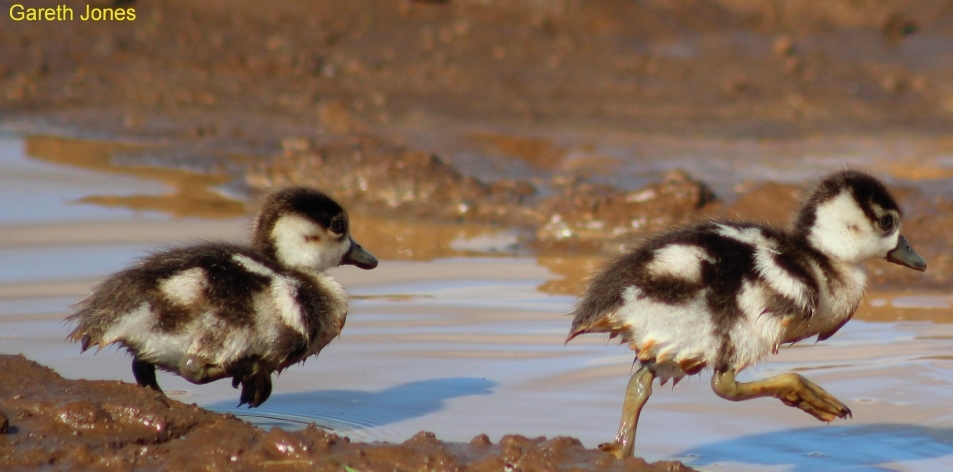
Feathered Fluffballs- Article by Gareth Jones
Feathered Fluffballs Of Nairobi National Park
Over the years, we have enjoyed many aspects of the Nairobi National Park, always with an air of expectation and anticipation mixed with the excitement of what could possibly be seen. There is something wonderfully special about watching birds, especially when they have tiny chicks, perhaps because they represent a new life? With over 500 species of birds recorded in the park, there is no shortage of species. However, there are many species that are resident and breed in the park. The bird species range from seed eaters, water birds, raptors, insect eaters, sunbirds etc.
In order to have a special ‘baby bird moment’, it is useful to note a few tactics that have certainly been very rewarding over the years. Firstly, find a place where there are a number of bird species thriving. Wetland places like the Hyena Dam, Athi dam, No 10 murram pits are typical rewarding locations. Secondly, sit quietly and observe the various species for at least 15 minutes, this is because the parent birds instinctively hide the chicks when they feel threatened, and noises like motor vehicles tend to reduce possible sightings. However, if you sit very quietly we have noted that many species start to behave naturally and that is when we have experienced most of our “baby bird moments”.
Over the years we have enjoyed so many aspects of the Nairobi National Park, even though I have visited the park more than 4500 times, each visit is always a special occasion, with an air of expectation and anticipation mixed with the excitement of what could possibly be seen.
There is always something attractive about water, perhaps because it brings life. Mankind also seems to be fascinated by water power like waves, waterfalls and flooding. The park has a number of water points spread about and includes many dams like the Athi dam and a number of seasonal streams that flow into the Mbagathi River.
One of my favourite seasonal dams in the park is the “murram heaps” near No 10 junction. The park was now looking green after a bit of rain, so we decided to check the small dams. Then…Wow! What a sight to see a pair of Egyptian geese as proud parents with their large family of fifteen newborn chicks. There is always something exciting and refreshing about seeing babies, and these little “fluffballs” were exceptionally cute, amazingly their colours and markings looked very different from their parents. I waited a while and watched them as they swam across the water, and went into the green cover on some lilies. Young chicks often have high mortality in the wild, however, I hope these young ducks do well to survive.
Egyptian geese are actually scientifically classified as ducks and have beautiful body markings when they mature into adults. It and it is worth spending some time watching them. Clearly, these proud parents now have a wonderful family to fight to protect.
On another occasion, early on a fresh crisp summer morning near the Kingfisher picnic sight, we had an interesting sighting. Ahead of us, a colourful flock of superb starlings looked wonderful with their beautiful shining feathers as the sun shone on them.
After stopping briefly to watch them, I was just about to start the vehicle engine when I noticed a superb starling landing with a dry stick in its beak, in a brief moment a young chick appeared and moved quickly towards the adult bird. The chick was no doubt very keen to have breakfast in the form of whatever edible meal was presented by the parent bird. However, with our human logic, it is often hard to imagine bird logic, but I did imagine for a moment that this was actually “Chick stick lesson #101” – with this superb starling seemingly educating its chick as if it was trying to say “If it is very hard and firm and does not squirm it is not a worm”. It was also very amusing to watch the chick repeatedly try to take the stick from the adult bird, hopefully, the chick did learn the “stick lesson”, and that sometimes grown-ups have more to do than just feed youngsters. Maybe the stick was eventually put to good use to help build a nest for future chicks?
I always find it a joy to see birds when driving in the park, God has created such amazing diversity. While driving away I reflected on our human lifestyles in that perhaps we could all learn a lesson from the ‘chick stick’ example, as at times we chase after dead and dry meaningless worldly things, when we should rather be seeking the best of what life has to offer. Mankind is supposed to be caring about creation, pray that our hearts change to love life!!!
It is interesting to note that bird chicks are often completely different from the adults as they are created with natural camouflage to increase their possibility of survival, as they often have high mortality in the wild. All babies have a high “cuteness factor” and chicks are especially unique little fluffballs. So why not try something different and try to have a baby bird moment and enjoy watching the little feathered fluffballs.


